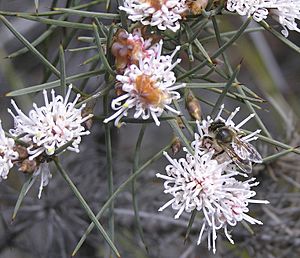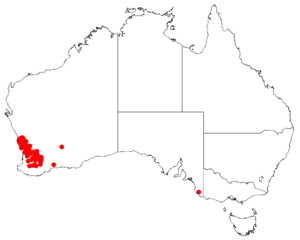Hakea gilbertii facts for kids
Quick facts for kids Gilbert's hakea |
|
|---|---|
 |
|
| Hakea gilbertii growing near Pingelly | |
| Scientific classification | |
| Genus: |
Hakea
|
| Species: |
gilbertii
|
 |
|
| Occurrence data from AVH | |
Gilbert's hakea (Hakea gilbertii) is a special type of shrub that belongs to the Proteaceae plant family. It grows naturally only in the Wheatbelt area of Western Australia. This plant is known for being upright and quite prickly. It has greyish, needle-like leaves and produces groups of sweet-smelling flowers from late winter into spring.
Contents
What Gilbert's Hakea Looks Like
This shrub grows straight up and has many branches, making it look very full. It can reach a height of about 2 to 7 feet (0.6 to 2 meters). The plant is quite prickly and does not have a special woody base called a lignotuber.
Gilbert's hakea blooms from August to September. During this time, it produces many sweet-smelling flowers. These flowers can be white, cream, or even red-pink. They grow in large groups where the leaves meet the stems.
The leaves of this plant are thin and look like needles. They are usually grey-blue in color and can be from 0.8 to 4 inches (2 to 10 cm) long. Each leaf is only about 0.04 inches (1 mm) wide and ends in a very sharp point. After the flowers, small fruits grow. These fruits are smooth but have bumpy parts and a small beak that points backward.
How Gilbert's Hakea Got Its Name
The plant Hakea gilbertii was first officially described in 1855. An English botanist named Richard Kippist wrote down its details. His description was published in a science journal called Hooker's Journal of Botany and Kew Garden Miscellany.
This plant was named after John Gilbert. He was an English naturalist and explorer who studied nature.
Where Gilbert's Hakea Grows and Lives
You can find Hakea gilbertii growing in Western Australia. Its range stretches from Eneabba in the north, through the middle of the Wheatbelt region, all the way south to Dumbleyung.
This plant can grow in different types of soil, including sand, loam, clay, and gravel. It is often found in areas with heath and scrubland. Gilbert's hakea grows best in sunny spots where the soil drains water well. It can handle frost and is also quite good at surviving dry periods. Because it grows so densely and is prickly, it makes a great home for birds.
Conservation Status: Is It Safe?
The government of Western Australia has looked at Hakea gilbertii. They have officially classified it as "not threatened." This means that the plant is not currently in danger of disappearing.

